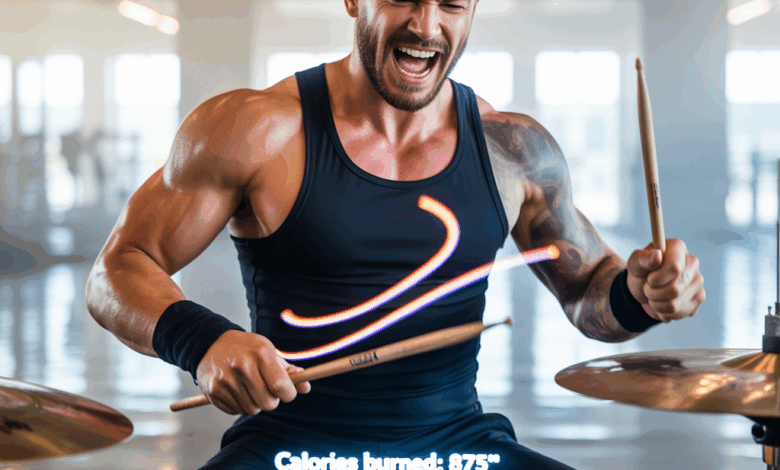How Many Calories Does Drumming Burn? A Drummer’s Guide to Calories, Cardio & Workout Tips

Ever left a two-hour band rehearsal soaked in sweat and wondered, “Did I just get a workout — and how many calories did drumming burn?” Whether you’re a hobbyist, gigging drummer, or just love air-drumming along to your favorite tracks, drumming can be a surprising source of exercise. Let’s break down the numbers, explain why drumming can be an effective calorie-burner, and show you how to turn practice into real fitness gains.
How many calories does drumming burn?
Short answer: it depends. The number of calories burned while drumming varies by body weight, intensity, duration, and whether you’re sitting or standing. Using METs (metabolic equivalents) gives a useful estimate. Light drumming is roughly 3–4 METs, moderate drumming about 4.5–6 METs, and very vigorous drumming (marching, fast rock sets, or energetic full-body performance) can reach 7+ METs.
Using the MET formula: calories/minute = MET × 3.5 × weight(kg) / 200.
- Example (70 kg / 154 lb):
- Light drumming (3 METs) ≈ 3 × 3.5 × 70 / 200 = ~3.7 kcal/min → ~220 kcal/hour
- Moderate drumming (5 METs) ≈ ~6.1 kcal/min → ~365 kcal/hour
- Vigorous drumming (7 METs) ≈ ~8.6 kcal/min → ~517 kcal/hour
So for the question “how many calories does playing drums burn,” expect a range roughly between 200 and 600+ calories per hour depending on intensity and your body size. Professional, marching, or highly active drum sessions can push the higher end of that range.
Why drumming is a surprising calorie burner
Drumming engages the upper body, core, and—if you use pedals—your lower body. Fast tempos and long sets require endurance, coordination, and stamina. Unlike stationary weightlifting, drumming often involves continuous movement, making it closer to a cardio activity. It’s also rhythm-driven, so you’re more likely to maintain momentum and push intensity without noticing the “work” as much.
Factors that affect calorie burn
- Body weight and composition — heavier and more muscular people burn more calories.
- Intensity and tempo — faster beats and energetic styles increase expenditure.
- Duration — longer practice sessions add up; three 30-minute sets can equal one intense hour.
- Posture and movement — standing, moving, and using pedal work raise the burn.
Real-world examples: calories burned in common drumming situations
- Casual practice (sitting, slow/medium tempo): ~150–300 kcal/hour
- Intense rehearsal (standing, fast rock or metal, active footwork): ~350–500 kcal/hour
- Marching percussion / extended gig with movement: ~500–800 kcal/hour
These are estimates, but they give a practical sense of what to expect. If accurate tracking matters, consider using a heart-rate monitor or fitness tracker calibrated to your weight and activity.
Turn drumming into a deliberate workout
Want to maximize the fitness benefits of drumming? Try these practical tips and workout variations that transform practice into a calorie-burning session.
Warm-up and mobility
- 5–10 minutes of dynamic arm swings, shoulder rotations, wrist circles, and light cardio (jumping jacks or marching in place).
- Warm-up rudiments at low tempo to prep tendons and muscles.
Drumming HIIT (High-Intensity Interval Training)
- Practice a 20–30 minute HIIT set: 1 minute of full-intensity blast (fast fills and footwork), 1 minute of light groove or rest. Repeat 8–10 times.
- Benefits: boosts cardiovascular fitness, burns more calories in less time, builds endurance for long gigs.
Full-body drumming routine
- 10 minutes steady groove (moderate intensity)
- 5 minutes of double-kick pedal work or fast foot patterns
- 5 minutes of standing grooves with movement (step side-to-side while playing)
- 10 minutes cool-down and stretching
Healthy lifestyle tips for drummers who want results
- Nutrition: fuel long rehearsals with balanced meals—complex carbs before long sessions and protein-rich recovery afterwards. See our nutrition guides for meal ideas tailored to active people.
- Hydration: keep water nearby during practice; sweating during extended gigs increases fluid needs.
- Sleep and recovery: aim for 7–9 hours; recovery influences how many calories your body burns and builds back muscle.
- Cross-training: add strength training and mobility work off the kit to improve power and reduce injury risk. Check our workout routines for sample sessions that complement drumming.
Equipment and environment tips to increase calorie burn
- Stand more often — standing drumming engages core and legs more than sitting.
- Use a heavier stick or add grip tape to promote stronger strokes (with caution to avoid overuse injuries).
- Play to faster, upbeat music or use a metronome at increased tempo to naturally elevate heart rate.
- Practice on a pad for focused speed and endurance drills — great for short, high-intensity sets.
Frequently Asked Questions
Drumming can be an effective cardio and muscular endurance workout, especially at higher intensities, but it’s typically lower-impact than running. For steady-state aerobic fitness, running/cycling might burn calories faster at similar effort levels. However, drumming adds coordination, upper-body conditioning, and is more enjoyable for many—so it’s a great complement to traditional cardio.
Use a heart-rate monitor or fitness tracker that considers your age, weight, and heart rate during activity. Wrist trackers can estimate energy expenditure, but chest straps paired with apps tend to be more accurate. For best results, combine device data with perceived exertion and session duration.
Air drumming and pad practice can burn calories, but typically slightly less than playing a full kit unless you’re intentionally moving and working at high intensity. Adding footwork and big arm movements increases the burn during pad or air sessions.
Conclusion — Ready to drum your way to fitness?
So how many calories does drumming burn? Anywhere from roughly 150 to 800 calories per hour depending on intensity, body size, and movement. Drumming can be a fun, effective form of exercise — especially when you structure practice with warm-ups, intervals, standing movement, and cross-training. Try a HIIT-style drumming session this week, track your heart rate, and see how practice doubles as a workout.
If you enjoyed these tips, explore more workout routines and wellness tips to build a balanced fitness plan that fits your band schedule. Want personalized guidance on turning your drumming into a fitness routine? Try timing a few sessions, note your intensity, and get in touch—or leave a comment below with your drumming goals!





